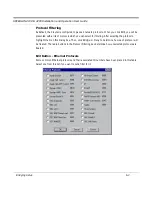
SPEEDLAN 4100 & 4200 Installation and Operation User Guide
6-6
Bridging Setup
•
Enable Learned-Table Lockdown
A standard bridge watches the source address of each packet it receives on any of its
interfaces. As new addresses are seen, entries are added to the
learned table
that con-
tains each source address and the interface number that address was received on. If a
source address is later seen on a different interface, the bridge will immediately change
the interface number in the learned-table entry. This condition could happen in a net-
work that is operating well if someone moved a computer to a different part of the net-
work. This could also happen if someone was trying to capture network packets by
fooling the bridge. Enabling learned-table lockdown will prevent the interface number
from being changed once the source address has been seen. A standard bridge will
also time-out the learned-table records every 10 minutes. If learned-table lockdown is
enabled, these records will not be timed out. Once a record is learned, it will not
change or be deleted until either the bridge reboots or the learned table become com-
pletely filled and needs to be reset. (NOTE: A typical SPEEDLAN learned table can con-
tain over 12,000 records.) The default value for this setting is disabled.
•
Enable Expanded IP ARP Support
Enabling this feature will cause the bridge to also watch the IP/ARP packets that occur
on the network. The SPEEDLAN 4100 & 4200 brouters take no action in response to
IP/ARP packets (since that is the role of an IP router) except to add the IP address to its
IP/ARP table. This feature is helpful on an IP network because it will build a database of
MAC-layer-address-to-IP address pairs. An SNMP monitoring program, such as the
SPEEDLAN Configurator, can at any time extract this information. NOTE: 1) The IP/ARP
table is never timed out in this mode. 2) This feature is not available if the brouter is
routing IP. The default value for this setting is disabled.
•
Permit Ethernet Broadcasts
Standard Ethernet bridges will always forward broadcast packets. Many protocols do not
use broadcasts (e.g., AppleTalk Phase II, DECnet, and others). However, IP/ARP does use
broadcasts. If you do not use IP or any other protocol that requires broadcasts, you can
deny them. Shutting off broadcast packets will reduce the traffic being sent across your wire-
less network link. This will also greatly reduce the number of interrupts that each computer
connected to your network experiences. Networks with a high number of broadcasts will
slow down the processing of all attached computers, even those that aren't using the net-
work.
•
Permit Ethernet Multicasts
Standard Ethernet bridges will always forward multicast packets. Some protocols do not use
multicast packets, such as TCP/IP and Novell IPX. If you do not use protocols that use mul-
ticast packets, you can drop them by disabling multicast on the brouter. This will reduce the
traffic that is sent across the wireless network link. In addition, it reduces the number of
interrupts that each computer connected to your network experiences.
Содержание SPEEDLAN 4100
Страница 7: ...Chapter 1 Introduction...
Страница 11: ...Chapter 2 Quick Start...
Страница 21: ...Chapter 3 Hardware...
Страница 25: ...Chapter 4 Overview of Configurator...
Страница 31: ...Chapter 5 Configuring SPEEDLAN 4100 4200...
Страница 43: ...Chapter 6 Bridging Setup...
Страница 53: ...Chapter 7 Setting Up the IP Addresses IP Host Setup...
Страница 67: ...Chapter 8 IP Router Setup...
Страница 73: ...Chapter 9 SNMP Setup...
Страница 77: ...Chapter 10 System Access Setup...
Страница 79: ...Chapter 11 SNMP Monitoring...
Страница 105: ...Chapter 12 Tables...
Страница 115: ...Chapter 13 Analyzing Wireless Equipment...
Страница 123: ...Glossary for Standard Data Communications...
Страница 141: ...Appendix Protocols Ethernet Addresses...
















































